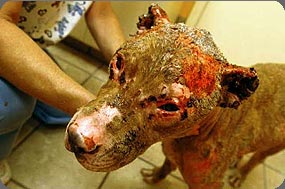
" Louis " who was consistently chained up was beaten, sprayed with lighter fluid and set alight by Juan Daniels. This was his mother's dog. Daniels did this because he was not allowed to borrow the family's car. Louis attended his abusers sentencing and he has now been adopted out to a loving home.
PASSIVE AND ACTIVE CRUELTY
There are two kinds of animal cruelty inherent across the spectrum of animal abuse. ACTIVE CRUELTY, which is cruelty inflicted (with deliberate intent to harm an animal creating immediate pain and suffering), and PASSIVE CRUELTY (harm inflicted via willful neglect creating prolonged suffering). One or both types are inherent cruelty to companion animals, animals used for research, industrial factory farmed animal cruelty, animals used for sport and ritual, hoarding, animals killed for their fur, skins and body parts and mass market puppy mill production.
Regardless of the arguments that it may be the "custom" to ritually slaughter an animal for its fur or skin, or eat the animals we call our companions, cruelty is cruelty and cannot be disguised. All animals killed in these practices are "SENTIENT." They feel excruciating pain, fear and terror. This fact cannot be disregarded. While no regard is paid to this fact in many other countries, as a European and North American society we have a choice and must choose not to support and to condemn this absence of regard.
Animal cruelty is no longer a simple issue and categorically cannot be ignored. Animal cruelty issues long considered a peripheral concern are no longer on the outskirts of our society. Clinicians, veterinarians and scientists are starting to see a shift in that mentality now. Animal cruelty is now recognized as signature pathology.
The precious animals we see in the media so badly abused are the publicized victim of a phenomenon that a growing number of professionals including police officers, prosecutors, psychologists, social workers, animal-control officers, veterinarians and dogcatchers are now addressing with a newfound vigor: wanton cruelty toward animals.
PERPETRATORS OF ANIMAL ABUSE
ACTIVE CRUELTY (Acts of Commission)
The Link Between Animal Cruelty (Domestic and Other Forms of Violence)
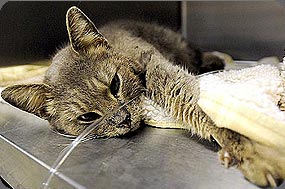
This little cat who was named DUTCH was found hanging upside down, nailed by one back leg to a utility post. He had also been beaten on the head and suffered blunt force trauma. Despite an out pouring of outrage and love for him and expert medical attention at the local veterinary clinic, he died two days after he was found.
Animal abusers are five times more likely to commit violent crimes against people. Deviant behaviors such as animal abuse generally originate from a traumatic childhood. The American Psychiatric Association considers animal cruelty as one of the diagnostic criteria of conduct disorder. The fourth edition of the Diagnostic and Statistical Manual of Mental Disorders (DSM) defines conduct disorder as "a repetitive and persistent pattern of behavior in which the basic rights of others or major age appropriate societal norms or rules are violated." Conduct disorder is found in those who abuse animals and abuse people.
Clinical evidence indicates that animal cruelty is one of the symptoms usually seen at the earliest stages of conduct disorder, often by the age of eight. This information has only recently been included in the DSM so some psychologists, psychiatrists, and social workers are just now becoming aware of it.
Many psychological, sociological and criminology studies in recent decades have clearly shown that violent offenders have adolescent histories of serious and repeated animal cruelty. The F.B.I. has analyzed the lives of serial killers and their findings suggest that most serial killers have killed or tortured animals as children. Further research has shown consistent patterns of animal cruelty among perpetrators of more common forms of abuse such as: child abuse, spouse abuse and elder abuse.
FBI Supervisory Special Agent Allen Brantley was quoted as saying, "Animal cruelty is not a harmless venting of emotion in a healthy individual; This is a warning sign." There are deep psychological issues that lead to violent crimes against people

This puppy had his ears cut off as prank! He has recovered and is now adopted into a loving home. Photo Courtesy of Queen Waldorf Fights Back.
Jason Baker, Director of People for the Ethical Treatment of Animals (PETA) Asia said, "We believe that cruelty to animals is not inherent, but learned. That being said, teaching kindness and respect for animals - in our schools and homes - will foster empathy, the ability to understand what someone else feels." He added, "Incorporating the simple concepts of kindness and respect into our daily lives and teaching our children to respect and protect even the smallest and most despised among us will help kids value one another."
The link between animal abuse and interpersonal violence is becoming so well established that many U.S. communities now cross-train social-service and animal-control agencies in how to recognize signs of animal abuse as possible indicators of other abusive behaviors
MOTIVATIONS
In 1985, researchers Stephen Kellert and Alan Felthous extensively studied the animal abuse phenomenon. They discovered several motivations that helped to characterize animal cruelty in adults, many of which are applicable to youth who abuse animals. Some motivations are:
- To enhance one's own aggressiveness. To shock people for amusement.
- Controlling an animal through inflicting pain as a result of the sense of loss of full control in one's own life. (Physically abused by parents.)
- Retaliation against a person by hurting their pet.
- To experience sadism (the suffering experienced by the animal).
Case reports and a youth interview study conducted by researchers Frank Ascione, T. Thompson and T. Black suggest a number of developmentally related motivations such as:
- Peer pressure
- Mood enhancement (e.g. animal abuse is used to relieve boredom).
- Sexual gratification (bestiality).
- Forced abuse (child is forced into animal abuse by a more powerful individual).
- Animal phobias.
- Post-traumatic play (reenacting violent episodes with an animal victim.)
- Imitation (copying a parent's or other adult's abusive "discipline" of animals).

Rescued puppy mill dog Classic. Yorkshire Terrier used over and over again for breeding, starving barely able to walk and suffering from near blindness from untreated eye infections.
Kellert and Felthous found that family violence, particularly alcoholism and paternal abuse, were significantly more common among aggressive criminals with a history of childhood cruelty toward animals. This connects with statistical information from animal control agencies in the United States. They say that in 80% of homes in which animal control agencies found abused pets, there had been investigations by child welfare agencies due to reports of physical abuse and neglect.
Dr. Randall Lockwood, who earned a doctorate in psychology and is senior vice president for anti-cruelty and training for the American Society for the Prevention of Cruelty to Animals, says that children and adolescents who are abusive to animals are often acting out violence experienced or witnessed in their home. Aggressive individuals usually become that way because of a real or perceived injustice.
Jeffrey Dahmer, David Berowitz, Ted Bundy, all sadistically tortured animals in their childhood. Brenda Spencer, who opened fire at a San Diego school, killed two students and injured nine other children. When she was young, she had repeatedly abused cats and dogs, often by setting their tails on fire.
The American Humane Association has compiled research showing the link between violent acts toward animals and violence toward people. Here's a sampling of the results that involve children:
Children exposed to domestic violence were three times more likely to be cruel to animals than children from nonviolent households.
In a Wisconsin study, 75 percent of battered women reported that pets had been abused in front of children.
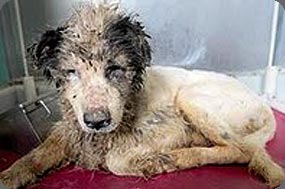
One of the puppies from the Gull Lake Manitoba Canada Hoarding Chernekie hoarding case that could not be saved, as he was in such severe distress.
A New Jersey study found, in pet-owning families being investigated for child abuse, that one-third of the children had abused animals, using them as scapegoats for their anger.
Sexually abused children were five times more likely to abuse animals, and 20 percent of children who sexually abused other children had histories of sexually abusing animals.
The FBI identifies animal cruelty as one of the juvenile behaviors associated with increasingly violent behavior.
Fifty percent of school shooters have histories of animal cruelty.
An abundance of research shows the close link between violent behavior toward animals and violent behavior toward people. They reveal the insidious and calculated motives for harming or killing another person's beloved pet, and the heartrending repercussions for the abused partners, their pets and their children.
- Up to 75 percent of domestic violence victims report that their partners threatened or killed family pets.
- Women seeking safety at domestic violence shelters are nearly 11 times more likely to report that their partner has hurt or killed pets than women who have not experienced domestic violence.
- 48 percent of respondents reported that animal abuse had occurred "often" during the past 12 months.
- 30 percent reported the abuse occurred "almost always."
- 51 percent reported that animal abuse incidents coincided with violent outbursts against human family members.
- 85 percent of the 50 largest shelters for battered women in the United States said clients discussed incidence of pet abuse in the family.
- Overall, 71 percent of women and 63 percent of children entering the shelters reported that animals had been the target of violence.
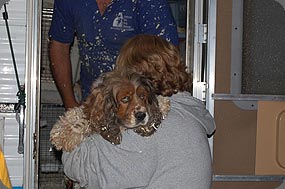
Very sick Cocker spaniel rescue form filthy puppy mill. She did recover.
Pet abuse is listed as a form of intimidation in the "power and control wheel," a landmark chart developed by the Domestic Abuse Intervention Project, the first multi-disciplinary program designed to address the issue of domestic violence.
Threats of harm to family pets may be used to coerce women who are battered into committing illegal acts at the behest of the batterer. A survey of 1,283 female pet owners found that domestic batterers who abuse pets use more forms of violence and demonstrate greater use of controlling behaviors over human victims than batterers who do not abuse their pets.
Thirty-two percent of battered women report their children had hurt or killed animals.
Children exposed to domestic violence are three times more likely to be cruel to animals than children living in nonviolent households.
Approximately 60% of college students who witnessed or perpetrated animal cruelty as children also reported experiences with child maltreatment or domestic violence.
OUR SOCIETY
As a society we need to be deeply concerned about this issue. A 2009 US study of 14,000 college students found that today's young people are 40 percent less empathetic than college kids from 30 years ago. The research was presented at the annual meeting of Association for Psychological Science. According to one of the lead researchers, Ed O'Brien, [AUDIO QUOTE] "It's harder for today's college student to empathize with others because so much of their social lives is done through a computer and not through real life interaction." With the rapid growth of social media, young adults are saturated with a social life rooted in technology! Feeling compassion and expressing empathy are just not a part of their daily interactions. This is a real threat to the well being of our young people
Recently a teacher reported students who had tortured some baby raccoons. She was rermanded for reporting an issue that was not really "school related." This was a serious mistake on behalf of the school board.
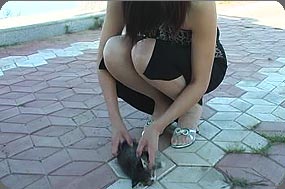
Dubbed the Kitten Killer of Hang Zhou China this woman was filmed playing with this kitten then crushing it to death with her shoes. She has been identified but under China laws, she has done noting illegal ! Facebook animal lovers identified her and her location from background scenery etc and have ensured her name was made very public. She has since resigned from her job and now lives in hiding. This CRUSH video was previously for sale on the web, but is no longer. New Legislation very recently passed in the United States has now banned the sale of CRUSH videos.
Animal cruelty is becoming more and more publicized in the media and the abuse more heinous. For example, dousing a dog in gasoline and setting it alight, nailing a cat to telegraph pole, microwaving a pet hamster, and the evolution of CRUSH videos. CRUSH videos are the filming of small animals like kittens, mice, hamsters and rabbits being systematically tortured by nail guns, sliced with knives, burned and finally stamped on by a woman in high heels or bare feet. The market for this sick and vile product is prodominantly in the United States.
The cost to our society from animal cruelty is incalculable and our Canadian criminal code totally inadequate to deal with it. Enforcement and social services agencies have to deal with the abused human victims. Safe houses and counseling have to be made available. Families are torn apart and children traumatized. In almost 70% of the domestic violence incidents the family pets were killed or tortured in front of a family member prior to that family member being abused.
Almost exlusively, no one paid any attention to the animal abuse!
It can now be said that when an animal is abused humans are at risk. The media, our government justice sytem, enforcement and social sevice agencies, schools and the public must now pay strict and prompt attention.
PREVENTION
If you see an act of violence against any animal, report it to both the local S.P.C.A. and to the police. If you know of or suspect there is violence in a neighbor's home or a child is being abused, the perpetrator could be a future violent criminal. It's a moral and civic duty to report these situations to local child welfare agencies.
Please click on the link to see the reality and nature of animal cruelty cases across Canada and the US: Queen Waldorf Fights Back!
ANIMAL HOARDING
CLASSIC PASSIVE CRUELTY (Acts of Omission)
Regardless of the henious act of animal cruelty, the nature of the act falls into one or other of two distinct categories, active by commission (willful intent, deliberate malice towards animals); or by an act of omission, the willful neglect to care for an animal. Animal hoarders are guilty of passive cruelty and come with their own profile and pathology, The typical animal hoarder is female, 60 plus and will typically "hoard" dogs or cats. Cats are more commonly hoarded than dogs.
What is an Animal Hoarder?

Puppy mill kennel after dogs have all been rescued, note the filth and debris!
According to a Tufts University ground-breaking study, Animal Hoarding "involves a compulsive need to obtain and control animals, coupled with a failure to recognize their suffering... (Rescue-Hoarders) obtain animals through actively seeking unwanted pets... from animal shelters or via the Internet... misrepresenting (themselves) as a legitimate rescue, shelter, or pet hospice."
Why Do People Hoard Animals?
It is not clearly understood why people become animal hoarders. Early research pointed toward a variant of obsessive-compulsive disorders, but new studies and theories are leading toward attachment disorders in conjunction with personality disorders, paranoia, delusional thinking, depression and other mental illnesses. Some animal hoarders began collecting after a traumatic event or loss, while others see themselves as "rescuers" who save animals from a life on the street.
One of the most perplexing facets of animal hoarding is that in the face of professed love and desire to care for animals, there can be tremendous animal neglect and suffering.... (Hoarders will) deny adverse events as obvious as starvation, severe illness and death... a desire to continue accumulation despite deteriorating conditions, is almost universal..." They have a "...resistance to adopt out animals they have "saved"... (and) the true reality of the animals' situation... boredom, fear, starvation, illness, and death... (is) met with denial or defensiveness."
Hoarder's dogs generally live a life of misery, often confined in stacked cages, enclosures, or runs, 24/7, no exercise, human affection, and often living in filthy conditions. Rescue-Hoarders may claim that their dogs have problems that prevent them from being adopted out, and solicit donations for the lifetime care of these "un-adoptable" dogs in their "sanctuary." The hoarders wrongfully believe they are helping the animals by keeping them indoors. In their mind, the cats and dogs are much better off with them than if they were unclaimed outdoors.
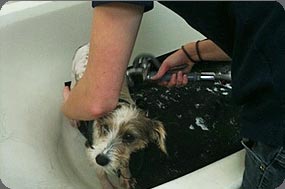
Puppy rescued from Puppy mill covered in his own feces and urine , being bathed and on his way to a new forever home.
The problem is that the animals, because of their sheer number, lack proper socialization skills. In short, they're feral. Between the lack of sociability and the fact that these animals are not house-broken (defecating and urinating on the floors and furniture), the possibility of any of these animals being a candidate for adoption after rescue is nil. "It is likely that up to a quarter million animals - 250,000 a year - are victims.
What explains behavior like this? Is there cruel intent behind it or is it simply a case of well-meaning people who took on too much responsibility? Are there psychological issues at play? Animal hoarding is a complex and intricate issue with far-reaching effects that encompass mental health, animal welfare and public safety concerns. Those "collected" range in species from cats and dogs to reptiles, rodents, birds, exotics and even farm animals.
The following criteria are used to define animal hoarding:
- More than the typical number of companion animals.
- Inability to provide even minimal standards of nutrition, sanitation, shelter and veterinary care, with this neglect often resulting in starvation, illness and death.
- Individual insists all animals are happy and healthy - even when there are clear signs of distress and illness.
- They have numerous animals and may not know the total number of animals in their care.
- Their home is deteriorated (i.e., dirty windows, broken furniture, holes in wall and floor, extreme clutter).
- There is a strong smell of ammonia, and floors may be covered with dried feces, urine, vomit, etc.
- Animals are emaciated, lethargic and not well socialized.
- Fleas and vermin are present.
- Individual is isolated from community and appears to be in neglect himself. Denial of the inability to provide this minimum care and the impact of that failure on the animals, the household and human occupants of the dwelling.
- A person has more than a typical (often illegal) number of animals.
- The animals are kept indoors or inside cages in the back yard.
- Homes where animal hoarders live give off a very offensive odor.
It's important to note that not everyone who has multiple animals is an animal hoarder. A person may have a dozen animals, and all are spayed and neutered and provided with regular veterinary care and a sanitary environment. This person would not be an animal hoarder. Even rescuers who occasionally become overwhelmed are not considered hoarders if they are actively trying to modify the situation.
According to the ASPCA, there is a dire need for coordinating efforts between animal control, mental health and social workers, and public health organizations to help combat the problem of animal hoarding. This problem also requires the assistance of family members and neighbors to step up and. report suspicions of animal hoarding.
Should Hoarders Be Prosecuted?
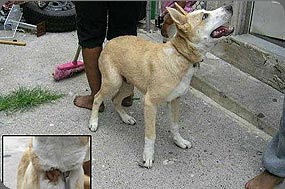
Dog with an embedded collar to the point it is that it is having difficulty breathing.
In most cases, criminal prosecution of animal hoarding can be a difficult process and may not be the most effective route. Such cases are difficult to successfully prosecute and, once released, the hoarder is likely to resume collecting an excessive number of animals unless closely monitored.
Some say prosecution isn't the answer because hoarders are often emotionally troubled rather than criminally inclined. "Like many psychological conditions, the causes of animal hoarding are probably multiple and, therefore, assessment of emotions, behavior and thoughts must be multifaceted to point the way toward successful treatment," says the ASPCA's Dr. LaFarge. In some cases judges can impose conditions that actually help the hoarder. They can require counseling, for instance, or ban the person from having animals.
What is clear is that prosecution alone rarely alters the behavior. "It is essential that key community agencies work together to prevent animal hoarders from harming the large number of animals they gain control over," says LaFarge. "Social service agencies must collaborate with animal shelters and law enforcement to intervene to save the animals and then follow up with years of monitoring to prevent a recurrence. The general public needs to be educated to realize that the hoarder is not just a nice little old lady who 'loves too much!"
The most recent hoarding in case in Canada was reported by the Winnipeg Humane Society, in which 61 dogs taken from the Judy and Peter Chernecki Gull Lake property, 90 kilometers north of Winnipeg Manitoba. Over half of the dogs seized from the filthy Gull Lake-area house that was the site of one the worst animal hoarding cases in the provinces recent memory, had to be put down.
If you are a veterinarian, a social worker, animal care rescue shelter worker or a neighbor and you suspect someone is "hoarding" please report your suspicions. Take photographs if you are able to safely do so, talk to your local animal shelter, humane society, MP, MLA, the local town council, local police, your local pound or animal control officer. You could be saving the lives of both the hoarders and the animals they have.
WILLFUL NEGLECT

Lucien left tied up to starve to death! He was near death when found but has recovered and is adopted into a d forever loving home.
Passive Cruelty (Acts of Omission)
The dictionary definition of the term willful is "an act that is undertaken that is of your own free will or design; done by choice; not forced or compelled."
Unless someone has been diagnosed with Alzheimer's or is suffering from a mental disorder, it is not possible that an individual cannot "literally" have any knowledge or recollection of the act of bringing an animal into their care and custody and consequently just "forgetting "about them. At some point or another the recollection that there is an animal outside in the yard, tied up in pen, restrained in any manner, or kept in a room in their house, will surface.
Any individual of sound reason knows full well that a sentient being (animal) requires care. Whether that care is minimal, the awareness that the animal requires food water and shelter is intermittently present. The act of choosing to ignore that awareness is an act of willfulness and therefore willful neglect.
The most common situations of willful neglect are found in the thousands of animals who are bought or adopted out to individuals who take them home and then categorically ignore them and their needs. This act of passive cruelty is nowhere more evident that the thousands of dogs who are just tied up and left outside. Frequently they are left with no food or water and relatively little, if any shelter.
Common signs of passive cruelty are listed below:
- Embedded collars
- Long overgrown claws or nails
- Chronic dental and eye infections
- Untreated broken bones (in any animal)
- Chronic tick, flea and parasite infestations (in any animal)
- Severe mange (in any animal)
- Untreated and open wounds on the body (in any animal)
- Patches of missing hair (in any animal)
- Extremely thin, starving animal (in any animal)
- Limping (in any animal)
- Dogs who are repeatedly left alone without food and water, and often chained in a yard
- Dogs, cats or other animals who have been hit by cars or injured in any way and have not been taken to a veterinarian
- Dogs or other animals (horses rabbits, etc.) who are kept outside without shelter in extreme weather conditions
- Animals who cower in fear or act aggressively when approached by their owners
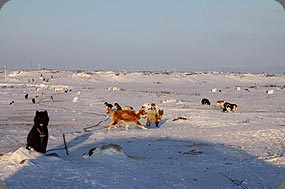
These are dogs on crown land in Churchill Manitoba belonging to Churchill resident Brian Ladoon. The dogs are chained out on lines with NO shelter NO water and fed every 2-3 days The are subject to -50 below temperatures on occasion ,polar bear and wolf attacks and eat snow for hydration. There are reportedly 200 dogs and they are there month in month out, year round ! The dogs have NO exercise and rarely any human contact. Dead dogs have been photographed on this property. This is one of the worst cases of CLASSIC passive cruelty currently existing in Canada.
Other - just as common - acts of passive cruelty are committed by those individuals who have an animal and leave their place of residence, leaving the animal behind locked in a room.
The long drawn out and painful suffering of any animal from willful neglect (passive cruelty) by omission is just as heinous a crime as a direct action taken to intentionally harm an animal (active cruelty) by commission.
The Canadian Criminal Code that addresses animal cruelty, while pitifully out dated and inadequate, states under the section:
WILLFUL ACTS AGAIN CERTAIN AND FORBIDDEN PROPERTY
Cruelty to Animals
Causing unnecessary suffering
446. (1) Everyone commits an offence who:
(a) willfully causes or, being the owner, willfully permits to be caused unnecessary pain, suffering or injury to an animal or a bird
One of the key reasons that Canada only has only a 1% animal cruelty case conviction rate, is that along with the totally inadequate legislation, lawyers do not have the required skills to determine and present active and/or passive animal cruelty case motions to the court. Judges have no idea as to how to determine a legal definition of the term willful.
"To inflict cruelties on defenseless creatures, or condone such acts, is to abuse one of the cardinal tenets of a civilized society - reverence for life." - Dr. Jon Evans
Research, photos and some text courtesy of Canadian Veterinary Medical Association, TUFTS, Hoarding of Animals Research Consortium, Humane Society of United States and the RSPCA
 " Louis " who was consistently chained up was beaten, sprayed with lighter fluid and set alight by Juan Daniels. This was his mother's dog. Daniels did this because he was not allowed to borrow the family's car. Louis attended his abusers sentencing and he has now been adopted out to a loving home.
" Louis " who was consistently chained up was beaten, sprayed with lighter fluid and set alight by Juan Daniels. This was his mother's dog. Daniels did this because he was not allowed to borrow the family's car. Louis attended his abusers sentencing and he has now been adopted out to a loving home. This little cat who was named DUTCH was found hanging upside down, nailed by one back leg to a utility post. He had also been beaten on the head and suffered blunt force trauma. Despite an out pouring of outrage and love for him and expert medical attention at the local veterinary clinic, he died two days after he was found.
This little cat who was named DUTCH was found hanging upside down, nailed by one back leg to a utility post. He had also been beaten on the head and suffered blunt force trauma. Despite an out pouring of outrage and love for him and expert medical attention at the local veterinary clinic, he died two days after he was found. This puppy had his ears cut off as prank! He has recovered and is now adopted into a loving home. Photo Courtesy of Queen Waldorf Fights Back.
This puppy had his ears cut off as prank! He has recovered and is now adopted into a loving home. Photo Courtesy of Queen Waldorf Fights Back. Rescued puppy mill dog Classic. Yorkshire Terrier used over and over again for breeding, starving barely able to walk and suffering from near blindness from untreated eye infections.
Rescued puppy mill dog Classic. Yorkshire Terrier used over and over again for breeding, starving barely able to walk and suffering from near blindness from untreated eye infections. One of the puppies from the Gull Lake Manitoba Canada Hoarding Chernekie hoarding case that could not be saved, as he was in such severe distress.
One of the puppies from the Gull Lake Manitoba Canada Hoarding Chernekie hoarding case that could not be saved, as he was in such severe distress. Very sick Cocker spaniel rescue form filthy puppy mill. She did recover.
Very sick Cocker spaniel rescue form filthy puppy mill. She did recover. Dubbed the Kitten Killer of Hang Zhou China this woman was filmed playing with this kitten then crushing it to death with her shoes. She has been identified but under China laws, she has done noting illegal ! Facebook animal lovers identified her and her location from background scenery etc and have ensured her name was made very public. She has since resigned from her job and now lives in hiding. This CRUSH video was previously for sale on the web, but is no longer. New Legislation very recently passed in the United States has now banned the sale of CRUSH videos.
Dubbed the Kitten Killer of Hang Zhou China this woman was filmed playing with this kitten then crushing it to death with her shoes. She has been identified but under China laws, she has done noting illegal ! Facebook animal lovers identified her and her location from background scenery etc and have ensured her name was made very public. She has since resigned from her job and now lives in hiding. This CRUSH video was previously for sale on the web, but is no longer. New Legislation very recently passed in the United States has now banned the sale of CRUSH videos. Puppy mill kennel after dogs have all been rescued, note the filth and debris!
Puppy mill kennel after dogs have all been rescued, note the filth and debris! Puppy rescued from Puppy mill covered in his own feces and urine , being bathed and on his way to a new forever home.
Puppy rescued from Puppy mill covered in his own feces and urine , being bathed and on his way to a new forever home. Dog with an embedded collar to the point it is that it is having difficulty breathing.
Dog with an embedded collar to the point it is that it is having difficulty breathing. Lucien left tied up to starve to death! He was near death when found but has recovered and is adopted into a d forever loving home.
Lucien left tied up to starve to death! He was near death when found but has recovered and is adopted into a d forever loving home. These are dogs on crown land in Churchill Manitoba belonging to Churchill resident Brian Ladoon. The dogs are chained out on lines with NO shelter NO water and fed every 2-3 days The are subject to -50 below temperatures on occasion ,polar bear and wolf attacks and eat snow for hydration. There are reportedly 200 dogs and they are there month in month out, year round ! The dogs have NO exercise and rarely any human contact. Dead dogs have been photographed on this property. This is one of the worst cases of CLASSIC passive cruelty currently existing in Canada.
These are dogs on crown land in Churchill Manitoba belonging to Churchill resident Brian Ladoon. The dogs are chained out on lines with NO shelter NO water and fed every 2-3 days The are subject to -50 below temperatures on occasion ,polar bear and wolf attacks and eat snow for hydration. There are reportedly 200 dogs and they are there month in month out, year round ! The dogs have NO exercise and rarely any human contact. Dead dogs have been photographed on this property. This is one of the worst cases of CLASSIC passive cruelty currently existing in Canada.